What are Cartesian robots? These robots are also known as 3-axis, gantry, or linear robots. They are the most commonly manufactured injection molding robots. This is because of the client’s preference and being termed as easy to use and program. Also, their configurations are flexible, enabling users to adjust speed and stroke.

Research has established that Cartesian robots are the most appropriate injection molding robots. These robots are precisely built for this procedure. They are industry-specific, and all their terminology is structured around the injection molding module.
This is ideal when the manual operator switches focus from working on the injection molding controls to the robot controls. This also aids in comprehending that Cartesian robots are intuitive and straightforward. This review will look at why Cartesian robots are the go-to option for all matters injection molding.
Why Cartesian Robots Are the Ideal Pick for Injection Molding
Floor Space
Floor space around an injection molding machine is a vulnerable and equally scarce commodity. With equipment such as manual operator work stations, temperature regulators, and granulators, there is competition for space around a molding cell.
A top tier Cartesian robot is the solution to space constrictions because it frees up some valuable floor space. Gantry robots can be mounted on top of the machine and still execute tasks well, being that their average reach is about 10 meters.
Robotic Layout Configuration
Cartesian robots offer a wider variety of mounting options to accommodate space constraints and project needs in comparison. With traditional rear side and operator side configurations still popular, we are seeing Cartesian robots with more varied layouts and having configurations such as reverse mount, clamp end, and T-mount.
One of the ways to save on space is setting up the robot to release parts at the clamp end of the molding device. This allows the machines to be placed close to each other, and configuring the gantry robot to traverse along the device to drop parts at the clamp end becomes easier.
Flexibility
There is no argument regarding articulated arm having a wide range of movement elasticity. That said, gantry robots can be tailored with servo turning axes on their arms. The additional axes can offer up to six axes of collective movement on the articulated arm.
Even though this in itself still does not equal the proficiencies of the articulated arm with regard to flexibility, these merits can provide gantry robots with a tad more flexibility than many deem to be conceivable.
Speed
In the molding industry, it is all about decreasing cycle time by cutting down on the mold open time. This an area in which Cartesian robots outdo themselves. The promptness of gantry robots is well known to exceed that of articulated arm robots and collaborative robots as well.
Faster in and out press translates to more parts being produced per hour, shift, or day in comparison with the other two. It equates to a quicker return on investment from Cartesian robots. These robots also have features explicitly designed to decrease parts removal times.
Payload
Both the six-axis and gantry robots have the capacity to process large payloads. In contrast to articulated arm robots, you have to put into consideration that the payload score can fluctuate. This is dependent on whether the robot is within its axis setting or functioning envelope.
Gantry robots, on the other hand, keep their rated payload abilities throughout their full range movements. These robots have the ability to clamp in place the largest payload size at all speeds. Collaborative robots atypically, have a much smaller payload capacity in comparison to articulated arm robots and Cartesian robots.
Conclusion
To sum it all up, Collaborative robots, six-axis robots and 5- axis servo robots have a crucial part to play in the plastics industry but they are not intricately suited to the removal of parts from molding machines a Cartesian robots are.
_____________________________________________________
Interesting related article: “What is Automation?“

